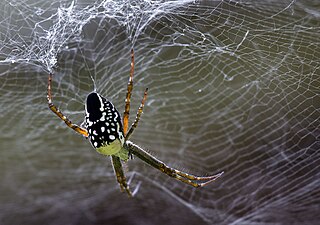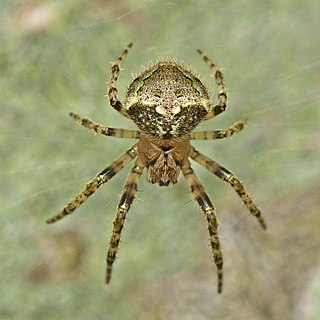
Orb-weaver spiders are members of the spider family Araneidae. They are the most common group of builders of spiral wheel-shaped webs often found in gardens, fields, and forests. The English word "orb" can mean "circular", hence the English name of the group. Araneids have eight similar eyes, hairy or spiny legs, and no stridulating organs.

Arkys, also known as triangular spider or ambush spider, is a genus of Australian araneomorph spiders in the family Arkyidae, first described by Charles Athanase Walckenaer in 1837. They are often small, with a triangular shaped abdomen, and are found in Australia and some of its surrounding islands. They don't build webs, but can often be found on leaves and tips of flower heads. Their egg sacs are pinkish-orange and spherical, and are made late in the summer.

Cyrtophorinae is a subfamily of spiders in the orb-weaver spider family. Unlike other orb-weavers, spiders belonging to Cyrtophorinae build horizontal, finely meshed platforms within a tangle of irregular webs. The usually dome-shaped platform is a non-sticky orb web.

Larinia is a genus of orb-weaver spiders first described by Eugène Simon in 1874.

Plebs is a genus of orb-weaver spiders first described by M. M. Joseph & V. W. Framenau in 2012. Though many of its species have been moved around, a 2012 taxonomic revision suggested that these spiders comprise a monophyletic genus of closely related spiders that evolved in Australia and, through subsequent movements, spread into parts of Asia and Pacific islands.

Arkyidae, also known as triangular spiders, is a family of araneomorph spiders first described by Ludwig Carl Christian Koch in 1872 as a subfamily of Araneidae, and later elevated to a full family in 2017.
Swolnpes is a genus of spiders in the family Anamidae. It was first described in 2009 by Barbara York Main and Volker Framenau. It is endemic to Australia.

Backobourkia is a genus of South Pacific orb-weaver spiders first described by Volker Framenau, Nadine Dupérré, Todd Blackledge & Cor Vink in 2010. It is a common Australian spider, closely related to Eriophora and placed in the "coxal hook clade" of the Araneinae subfamily of Araneidae. Females are generally the same size among all species, but males are much smaller, suggesting male dwarfism throughout the genus. The genus name is a play on the well-known Australian idiom, "Back of Bourke", meaning very remote and beyond the limits of civilization.
Demadiana is a genus of Australian araneomorph spiders in the family Arkyidae, first described by Embrik Strand in 1929.
Exechocentrus is a genus of Madagascan orb-weaver spiders first described by Eugène Simon in 1889. It is a bolas-using spider, capturing its prey with one or more sticky drops at the end of a single line of silk rather than in a web.
Taczanowskia is a genus of orb-weaver spiders first described by Eugen von Keyserling in 1879. Contrary to the common name of the group, spiders of the genus Taczanowskia do not build webs and are furtive hunters, deceiving their prey by producing sex pheromones that attract male moths, and catching their prey by using a pair of enlarged claws at the tip of their anterior legs.

Telaprocera is a genus of Australian orb-weaver spiders first described by A. M. T. Harmer & V. W. Framenau in 2008. As of April 2019 it contains only two species.
Tapetosa is a genus of spiders in the family Lycosidae. It was first described in 2009 by Framenau et al.. As of 2017, it contains only one species, Tapetosa darwini, found in western Australia.
Lariniophora is a genus of orb-weaver spiders containing the single species, Lariniophora ragnhildae. It was first described by V. W. Framenau in 2011, and is only found in Australia.

Cyrtarachninae is a subfamily of spiders in the family Araneidae. The group has been circumscribed in several different ways. It originated as the group Cyrtarachneae, described by Eugène Simon in 1892. The group was later treated at different ranks: as a tribe, both under Simon's name and as Cyrtarachnini, and as the subfamily Cyrtarachninae. Circumscriptions have varied. The broadest circumscription, Cyrtarachninae sensu lato (s.l.), includes three of Simon's original groups, including the bolas spiders. Unlike most araneids, members of the subfamily do not construct orb webs, some not using webs at all to capture prey, some using one or more sticky drops on a single line, while others construct webs with few widely spaced non-spiral threads, some triangular. Many have been shown to attract prey by producing analogues of insect sex pheromones, particularly to attract male moths. Adult females may mimic snails, bird droppings and other objects, and so are able to remain exposed during the day time, capturing prey at night.
Exechocentrus lancearius is a species of spider in the orb-weaver spider family Araneidae, found only in Madagascar. It was initially described from a partial specimen of an adult female. The first description of a complete specimen and its prey-catching behaviour was published in 2012. E. lancearius is a bolas spider. Rather than using a web, adult females catch their prey by using a line with one or two sticky drops which they swing.
Ordgarius monstrosus is a species of spider in the orb-weaver spider family Araneidae, found in Queensland, Australia. O. monstrosus is a bolas spider. Rather than using a web, adult females catch their prey by using a line with one or two sticky drops which they swing.

Ordgarius sexspinosus is a species of spider in the orb-weaver spider family Araneidae, found from India to Japan and Indonesia. O. sexspinosus is a bolas spider. Rather than using a web, adult females catch their prey by using a line with one or two sticky drops which they swing.

Hortophora is a genus of South Pacific orb-weaver spiders first described by V. W. Framenau, R. L. C. Baptista and F. S. M. Oliveira in 2021.
Swolnpes darwini is a species of mygalomorph spider in the Anamidae family. It is endemic to Australia. It was described in 2009 by Australian arachnologists Barbara York Main and Volker Framenau.










